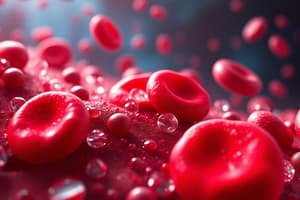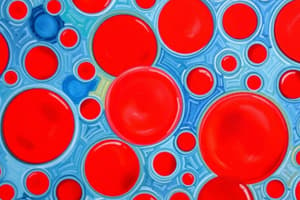Podcast
Questions and Answers
What percentage of human body weight does blood make up?
What percentage of human body weight does blood make up?
- 20%
- 1%
- 50%
- 8% (correct)
Which formed elements are found in the blood?
Which formed elements are found in the blood?
- Erythrocytes
- Leukocytes
- Thrombocytes
- All of the above (correct)
What approximate percentage of whole blood volume do blood cells constitute in adults?
What approximate percentage of whole blood volume do blood cells constitute in adults?
- 10%
- 75%
- 99%
- 45% (correct)
What is the liquid component of blood called?
What is the liquid component of blood called?
Which of the following is a function of the blood?
Which of the following is a function of the blood?
What gases does blood transport?
What gases does blood transport?
Which of the following is a function of erythrocytes?
Which of the following is a function of erythrocytes?
What is the shape of an erythrocyte?
What is the shape of an erythrocyte?
Which type of blood cell lacks a cell nucleus?
Which type of blood cell lacks a cell nucleus?
What is the primary function of leukocytes?
What is the primary function of leukocytes?
From what type of cell are platelets derived?
From what type of cell are platelets derived?
What is the function of platelets?
What is the function of platelets?
From what substance are steroid hormones made?
From what substance are steroid hormones made?
Where are steroid hormones produced?
Where are steroid hormones produced?
What property describes steroid hormones?
What property describes steroid hormones?
How do steroid hormones travel in the bloodstream?
How do steroid hormones travel in the bloodstream?
How do steroid hormones affect the cell?
How do steroid hormones affect the cell?
What are non-steroid hormones primarily composed of?
What are non-steroid hormones primarily composed of?
What is a characteristic property of non-steroid hormones?
What is a characteristic property of non-steroid hormones?
How do non-steroid hormones affect gene expression?
How do non-steroid hormones affect gene expression?
Flashcards
Blood Composition
Blood Composition
Blood consists of cells, cell fragments, and plasma (an aqueous solution).
Blood's Functions
Blood's Functions
Blood transports gases, nutrients, and waste products, and carries chemical messengers.
Hematocrit
Hematocrit
Volume percentage of blood cells in whole blood; about 45% in adults.
Erythrocytes
Erythrocytes
Signup and view all the flashcards
Leukocytes
Leukocytes
Signup and view all the flashcards
Platelets
Platelets
Signup and view all the flashcards
Steroid Hormones
Steroid Hormones
Signup and view all the flashcards
Non-Steroid Hormones
Non-Steroid Hormones
Signup and view all the flashcards
Amino-Acid Hormones
Amino-Acid Hormones
Signup and view all the flashcards
Lipophilic Hormones
Lipophilic Hormones
Signup and view all the flashcards
Hydrophilic Hormones
Hydrophilic Hormones
Signup and view all the flashcards
Study Notes
- Blood makes up about 8% of human body weight.
- Blood contains erythrocytes, leucocytes, thrombocytes, and plasma.
- The volume percentage of blood cells in whole blood is about 45% in adults, this is the hematocrit.
- The remaining volume is liquid plasma, which consists of water, plasma proteins, and electrolytes.
- Blood is composed of cells, cell fragments, and aqueous solution (plasma).
Functions of Blood
- Transports gases such as oxygen, carbon dioxide, and nitrogen, as well as nutrients and end products of cell metabolism.
- Tissues are supplied with blood gases and nutrients from the blood stream.
- In exchange, the bood stream transports end products like carbon dioxide, urea, uric acid, and creatinine to the lungs, liver, and kidneys.
- Carries chemical messengers or hormones to their target organs.
- Acid-base homeostasis is regulated through gas diffusion between alveoli and blood in the lung, known as alveolar diffusion.
- Blood transports oxygen from the alveoli to body cells.
- Oxygen diffuses to tissues, while carbon dioxide diffuses from cells into the blood.
- Blood balances water levels between capillaries and intracellular and extracellular spaces.
- Blood maintains a constant body temperature.
- Blood contains coagulation factors (proteins).
- It halts bleeding by activating coagulation factors in response to blood vessel damage, ultimately leading to thrombus formation.
Blood Cellular Components
- Erythrocytes transport oxygen from the lung to tissues.
- Oxygen binds to the heme group of hemoglobin in erythrocytes.
- Erythrocytes are round and have a biconcave shape without a nucleus with a diameter of 8 to 10 µm.
- Leukocytes have a nucleus.
- The types of leukocytes include neutrophils, lymphocytes, monocytes, eosinophils, and basophils.
- Leukocytes function in immune defense.
- Platelets are derived from megakaryocytes.
- They enable hemostasis when damage to blood vessels occurs.
Hormones
- Endocrine glands secrete hormones into the bloodstream.
Classification of Hormones and Receptors
- There are steroids, non-steroids and amino-acid based hormones
Steroids
- Steroid hormones are made from cholesterol.
- Steroid hormones come from the adrenal glands and the gonads.
- Being hydrophobic or non-polar, steroid hormones do not like watery environments.
- They travel through the bloodstream bound to transport proteins to reach their target cells.
- Steroids can diffuse across the phospholipid membrane of target cells.
- Once inside, they bind to receptors that activate certain genes in the nucleus.
Non-steroids
- Non-steroid hormones are either peptides or proteins.
- They are hydrophilic and do not require transport proteins.
- Since they can't pass through the phospholipid bilayer, these hormones bind to cell surface receptor proteins.
- Once the receptors bind, they change shape activating proteins and enzymes that alter gene expression.
- The non-steroid hormone never enters the cell, but there is a change inside of it.
Amino-acid hormones
- These hormones derive from the amino acid tyrosine.
- Thyroid hormones, epinephrine, and norepinephrine fall into this category.
Studying That Suits You
Use AI to generate personalized quizzes and flashcards to suit your learning preferences.




